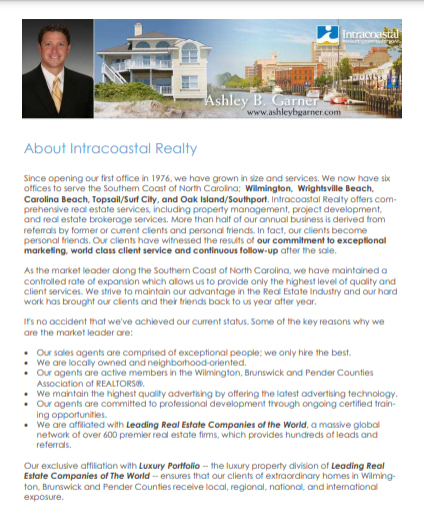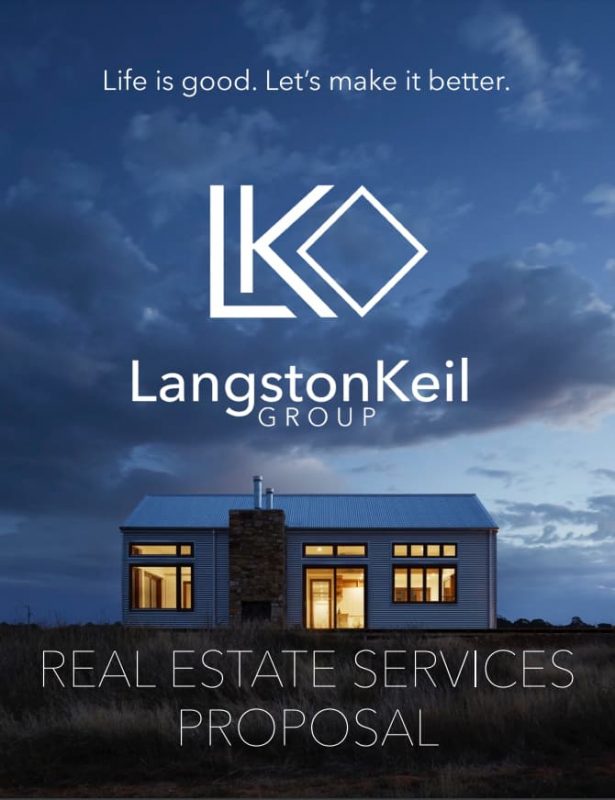A prelisting package (a pitch packet or pitch deck) is a document you send to sellers before a meeting to introduce yourself and explain why they should list with you. It includes a personal introduction, marketing plans, and performance statistics to show potential clients that you understand today’s market and are valuable to their homeselling process. A comprehensive prelisting package can take a potential client from a skeptical lead to a loyal customer.
Download our free prelisting checklist below and then read along for a breakdown of each element to include in your prelisting package.
1. The Introduction Letter
The introduction of your prelisting presentation should be a personalized letter that directly addresses the homeowner and explains what the package includes. You don’t have to write a new letter every time, and you can save time in the future by creating a basic prelisting packet introduction letter, but you should include some personalization.
Dear ________ (Seller Name(s)),
I look forward to chatting with you about the sale of your house at _________(insert property address). Our ultimate goal is to sell your home for the most money and in the shortest amount of time. We have outlined our strategies within this package. The methods we discuss will give us the greatest possibility of achieving these goals with you.
I’ve attached various helpful documents about the homeselling process and the services I will provide. I’m eager to communicate with you, sell your house, and assist you, your friends, and your family with your real estate goals.
Best,
Your Name
Your Phone Number
Your Email Address
Your Website and Social Media Handles (if Applicable)
Since your prelisting presentation packet is meant to demonstrate why you are uniquely qualified to sell their home, sending them a generic package with clip art won’t be impactful. Instead, prepare an introduction letter template for types of listing clients, like FSBOs (for sale by owner), expired listings, real estate referrals, or leads from your sphere of influence.
2. A Brief Professional & Personal Biography
The next section of your prelisting package template should be a brief biographical summary (aka bio section), similar to a resume. While your leads won’t have the time or interest to read through your junior high soccer history, they want to get a sense of your success as a real estate professional and who you are as a professional. After all, they will be working with you on what may be a stressful and emotional transaction for the next few months.
Make sure your bio includes the following:
- Brief summary of your experience
- What makes you unique
- Testimonials from former clients
- Your headshot
- Any real estate designations and their importance (make it clear how it helps your clients)
- Personal tidbits about you so clients can relate
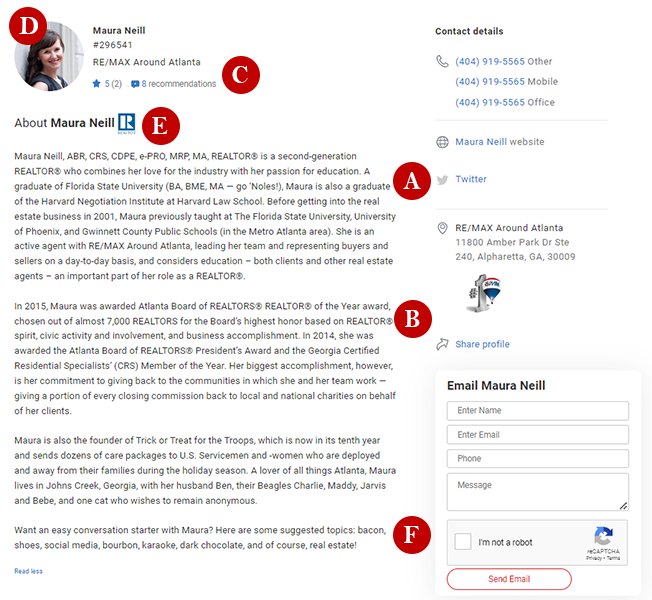
Example real estate bio (Source: Realtor.com)
3. Introduction to Your Brokerage & Team
While most homesellers focus more on the real estate agent than their real estate brokerage, providing a brief overview of your brokerage and team is beneficial. It shows clients what services you can offer and that you have additional resources at your disposal.
Include information about your brokerage’s history, sales records, awards, and current or recent real estate listings comparable to the prospect’s home. Also, add evidence of your firm’s marketing prowess to assure prospective real estate clients that a top-notch brokerage further supports your efforts.
If you work within a real estate team, this is the time to introduce each member’s name and job position, especially any team members the sellers will contact or may be working with in case of your absence. Include short bios with headshots of your team leader, associate broker(s), marketing support, and virtual assistant to let potential listing clients know who they should talk to if issues arise.
4. Marketing & Advertising Plan
While you should hold off on making specific pricing recommendations or sharing customized marketing plans (this will be done when you’re hired), you should include an overview of the marketing skills and tools you plan to use to capture and generate high-quality leads. The following are some examples of marketing materials and strategies to help you grow your audience and increase your engagement:
- Virtual staging or tours
- Online real estate ads through social media platforms
- Direct mailing
- Postcards
- Flyers
- Social media posting on Facebook or Instagram
- Syncing your real estate listings to various online platforms, like Zillow or Realtor.com
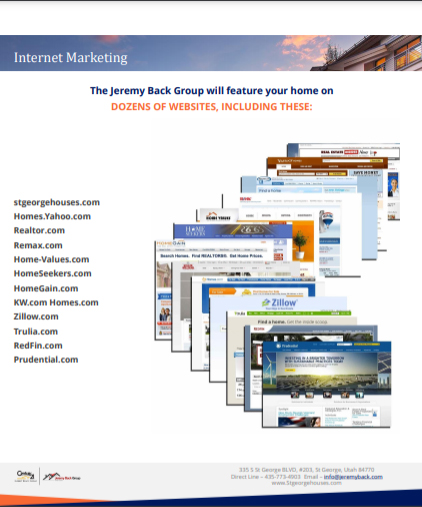
Real estate prelisting packet example of marketing strategy (Source: Sample Marketing Strategy)
Furthermore, include a marketing case study to show how you achieved a successful sale with a similar home. The study should provide specific details about the tactics you used to demonstrate a property’s value, time on the market, and marketing channels you used. For example, if you’re pitching an FSBO lead, include a marketing case study on an FSBO property you recently closed. Show the channels you used to market the property and statistics to depict these channels’ success and closing timeline.
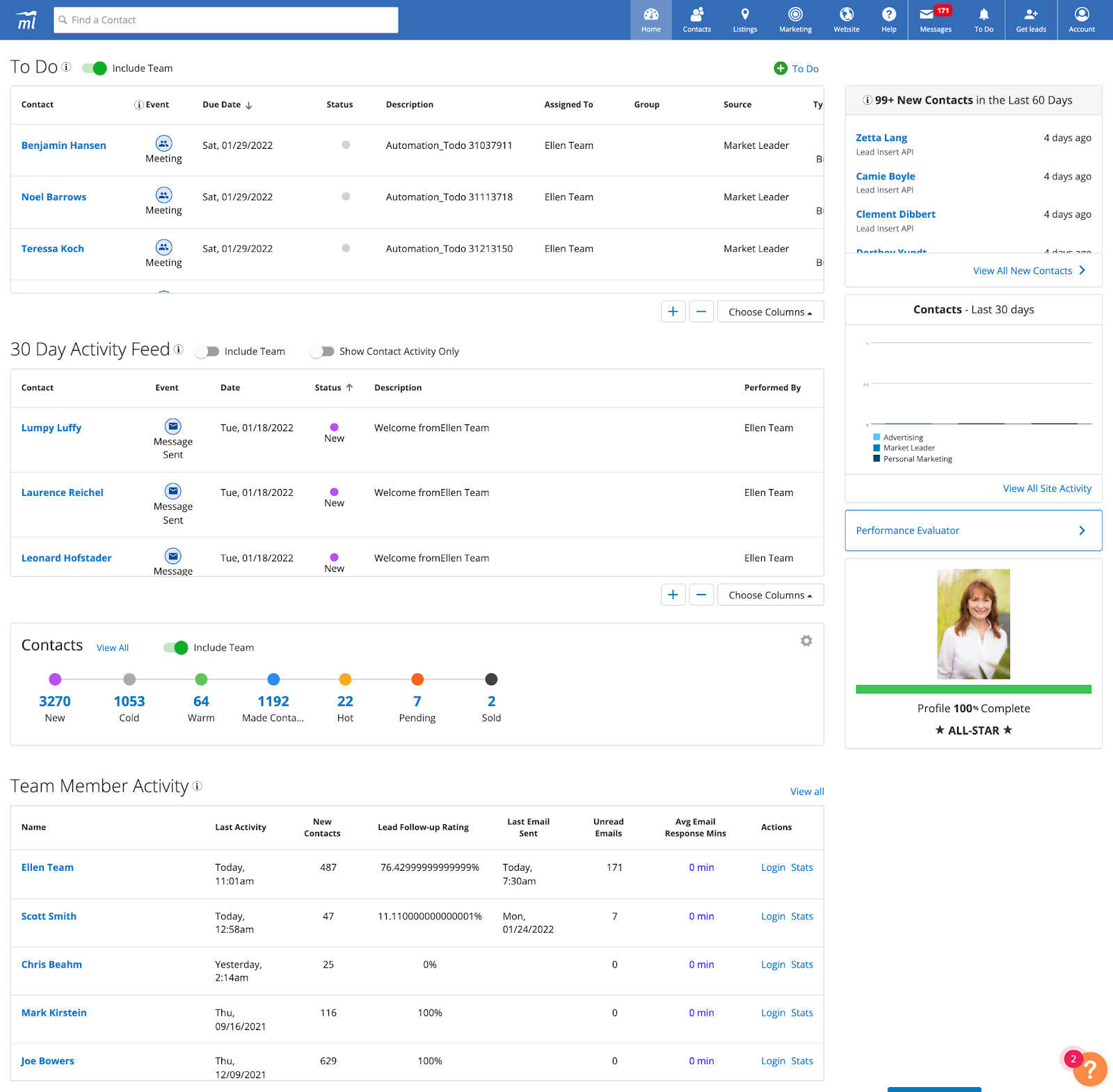
Market Leader agent dashboard (Source: Market Leader)
For agents and brokerages that require lead generation and marketing tools, check out Market Leader. It provides exclusive leads, print and online advertising, and a website builder to help you make your marketing efforts more efficient and stand out from the competition. It also features client relationship management (CRM) integration with 40-plus lead sources, including Zillow, Trulia, and Realtor.com.
5. Statistics Showing Strong Performance
Along with introducing your brokerage, include statistics about your performance and the performance of your brokerage. These numbers will show your listing clients how quickly you’ve been able to sell houses and how well you can achieve (or even exceed) the listing prices.
Statistics like the average days on the market, the percentage of sales closed over ask, and the number of sales closed in a specific area will support and act as evidence for your claims. Incorporate pictures and data for comparable properties to show your neighborhood expertise. This can help establish your presence and value of knowledge in the area where your potential client is selling their home.
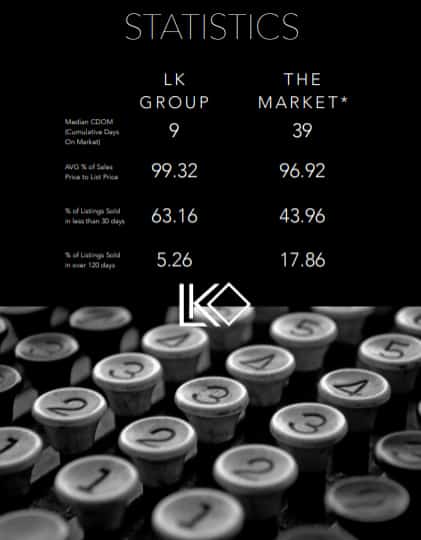
Sample company market statistics (Source: Sample Statistics)
6. An Overview of the Sales Process
Including an overview of the sales process gives homeowners a clear view of their next steps and helps them envision working with you. While you don’t need to write lengthy explanations of the sales process or cover all of the possibilities, a bulleted list of the basics will go a long way to educating your clients and demonstrating your value.
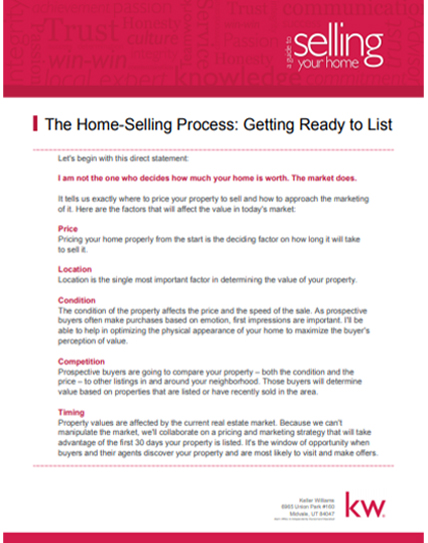
Example of an overview of a sales process (Source: Double Edge Homes)
Be sure to include information about how negotiations work, the fee structure for sellers, and any additional services they’ll need, such as title company, escrow, real estate attorney, and mortgage broker. The list you give clients should match your real estate listing checklist to keep everyone on the same page throughout the process.
7. Market Statistics & Explanation of Comparative Market Analysis (CMA)
The prelisting package is the place to introduce local real estate market data. Include a few statistics about similar homes in the prospective client’s area and mention that you’ll present a comparative market analysis (CMA) during your meeting. Don’t send the complete CMA to the sellers before your listing presentation, but explain what it is and how it will help them price their home accurately so they can get the most money from the sale of their home.
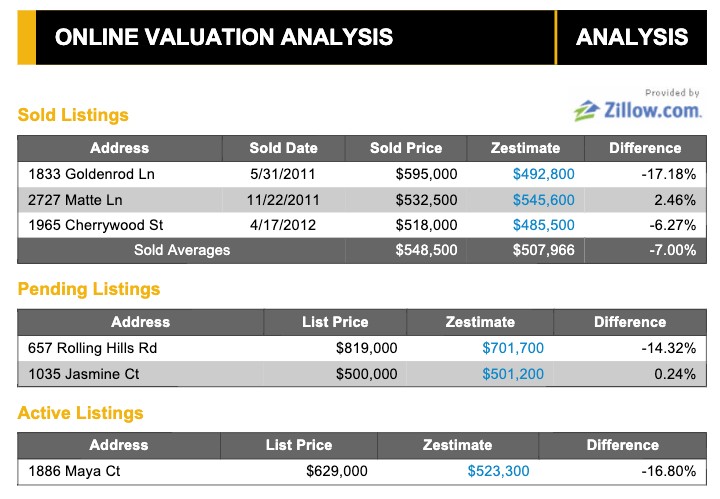
Example of a simple CMA PDF (Source: California Solutions Team)
Providing this data and information gives homeowners time to think about the market data and anticipate the information that will be included in your CMA. You can also mention that you must tour their home before making a final pricing recommendation and ask to schedule a time.
8. Sample Contracts & Disclosures
Including a sample real estate listing agreement contract in your prelisting packet helps sellers consider getting their property on the market. Homeowners are often so focused on the overwhelming number of tasks and decisions they’ll have to make to list their home that they don’t think about other vital details, like contracts and disclosures. These documents prepare them for what they’ll face during and after accepting an offer.
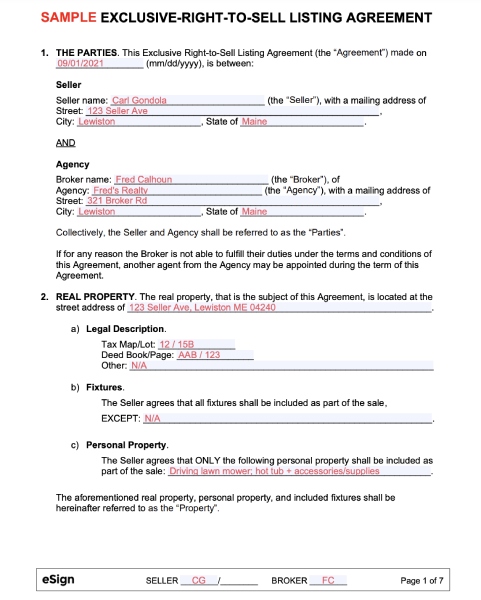
Example of an exclusive contract or disclosure (Source: eSign)
When you and the homeowners are on the same page about the homeselling process and their goals, it allows the whole process to run more smoothly. It will also give you a moment to explain these documents, giving homeowners transparency throughout the process. Discussing potential disclosures during the listing presentation often reveals important information that prevents problems or miscommunications.
9. Checklists & Anticipatory Questions
A great way to end your prelisting package is with a checklist and questions for the homeowners to consider when choosing an agent to list their home. This helps prepare them for your listing presentation meeting and shows them that your priority is genuinely helping them in the best possible way. Of course, when you present a list of questions to ask a real estate agent, you should also be prepared to answer each question.
- Is it a buyers’ market or a sellers’ market?
- Should I hire a real estate agent or sell my home alone?
- What about all the paperwork and legalities? Can I do it all by myself?
- How much should I price my home?
- What should I do to have my home in top-selling condition and increase the property’s value?
- Should I do some renovation or not? If yes, how much should I allot for the renovation?
- How much should I fix? How much should I leave as is?
- Which part of the property needs to be renovated?
- Should I hire a contractor, painters, homestagers, and photographers? Or will I do everything on my own?
- What marketing strategies are effective and will help me sell my home quickly?
- Do I need to host an open house? If so, how many?
- How much of a hassle is involved in showing my home?
- Should I list my home on public sites like Zillow and Realtor.com?
- Should I buy or rent my next home? If I buy a home, how will I finance it?
You can also personalize these questions based on the seller’s situation. For instance, if your potential client is an FSBO or expired listing, include questions like “How long have you been trying to sell your home?” and “Do you have access to all the appropriate contracts, disclosures, and other legal paperwork?”
Prelisting Package Best Practices
Like most effective marketing materials, building an excellent prelisting presentation is as much an art as it is a science. What you include will be primarily determined by your experience, preferences, skills, and what type of homeowner you’re pitching. This is why you want to keep the various sellers in mind when constructing your package—to tailor it to their particular needs.
For example, a for sale by owner (FSBO) lead needs different types of education than a typical seller (e.g., the value of working with an agent rather than selling their home independently). A first-time seller might need a more in-depth understanding of the homeselling process than someone who’s sold multiple homes. Or an expired listing seller might need to be re-encouraged to work with an agent if their first agent failed to sell their home the first time.
However, in general, a prelisting package should address the following:
- Demonstrates how the real estate agent can sell the client’s home to meet the homeowner’s goals
- Describes what the homeowner can expect during the process of selling their home
- Gives the homeowner an in-depth look at the agent’s marketing and sales skills
- Provides statistical and social proof of the agent’s successful track record
- Provides the homeowner with a realistic view of the marketplace and how it relates to their property
It is also good to send a prelisting package at least a few days before your first meeting with a potential client. This way, the sellers can review the prelisting package before the actual listing presentation.
Examples of Prelisting Packages
Here are some prelisting packet examples that will guide you in creating an excellent prelisting packet that will convert your leads into clients. These prelisting package examples showcase the above items, like an introduction letter, professional biography, and market statistics, demonstrating the agent’s expertise and achievements.
Frequently Asked Questions (FAQs)
A realtor prelisting packet is a marketing document you give to a potential client to enlighten them about the selling process and persuade them to cooperate with you. To give your prospect some background and demonstrate to them how you operate and what they can expect, you should present this package to them before the listing consultation. This realtor prelisting packet should be concise, persuasive, and easy to understand so that you can present your services with ease and confidence.
Winning and creative prelisting packets for real estate professionals typically include the following components:
- Your biography
- Client testimonials
- Your strategy or plan for marketing
- Previous examples of your best-performing marketing resources
- Market statistics
- Your competitive value
The benefits of creating a prelisting packet before meeting a potential client are it makes you stand out from other realtors, and it helps to build credibility and trust. It also showcases your expertise in the industry and sets the stage for a successful listing presentation.
Bottom Line
Your prelisting package is one of the most effective and influential real estate lead generation tools you can create, so spending some time and money to make it shine can positively impact your entire business. Creating different real estate prelisting packages for different types of homesellers and including the correct information will maximize your chances of converting real estate leads into real estate listings.

